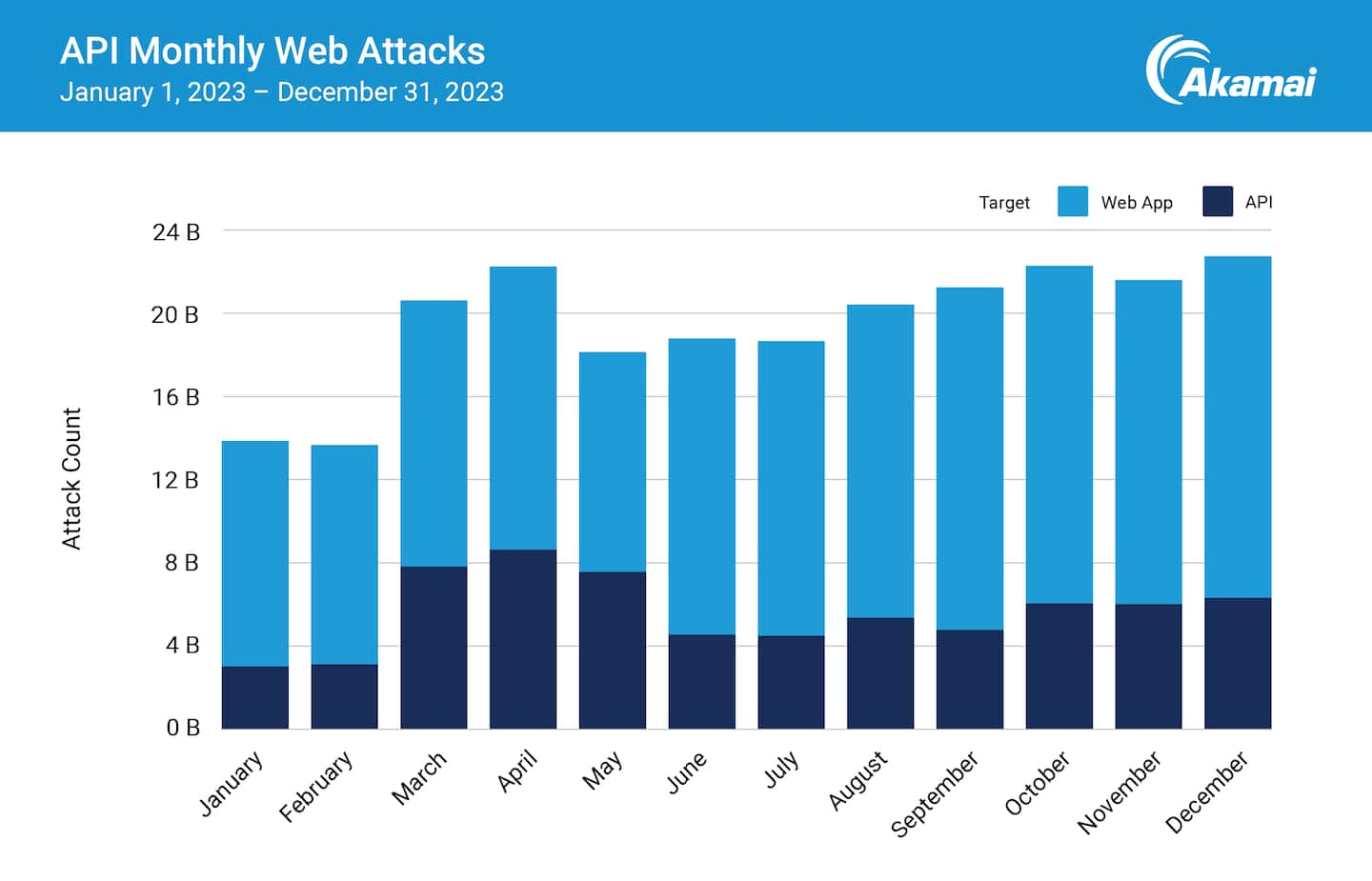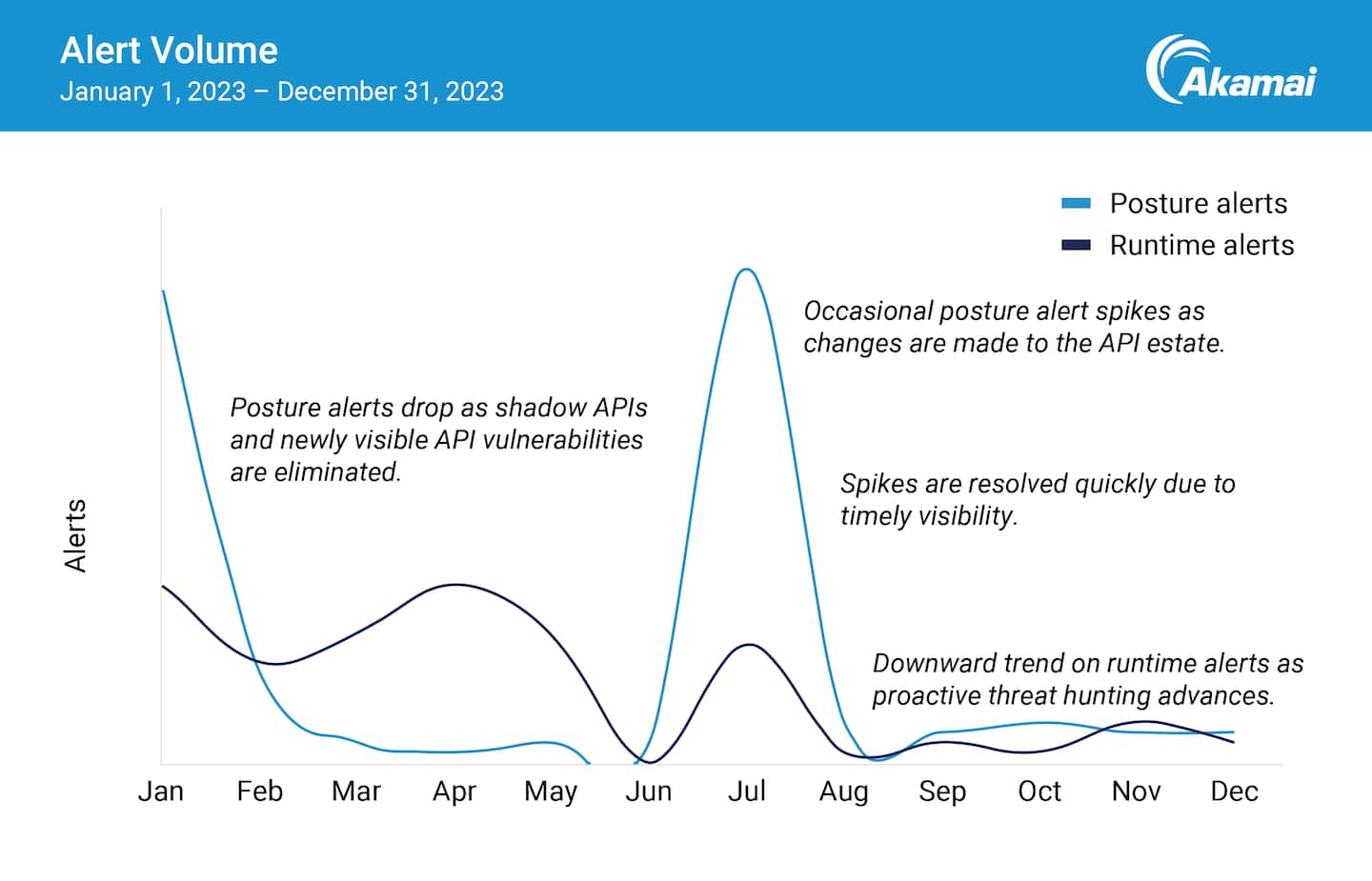Lurking in the Shadows: Attack Trends Shine Light on API Threats
This year kicks off the 10th anniversary of Akamai’s State of the Internet (SOTI) reports in which we share our threat insights and data findings. The focus of these reports has morphed over the years because the operational and threat ecosystems have evolved. One key change this year: Instead of looking at web application and API attacks as a single set, we separated them to allow more detailed situational awareness.
An overarching theme for API security is the need for visibility. Business transformation has driven the use of APIs, but their rapid deployment has led to blind spots like zombie, shadow, and rogue APIs. As such, you need cyber controls to find and manage all APIs.
The most recent SOTI report, Lurking in the Shadows: Attack Trends Shine Light on API Threats, highlights the array of attacks hitting both websites and APIs, including traditional web attacks as well as API-specific attacks such as posture and runtime challenges that can lead to abuse or allow direct attacks. The report also touches on best practices to mitigate threats and emerging compliance challenges.
Key insights of the report
A total of 29% of web attacks targeted APIs in the span of 12 months (January – December 2023), indicating that APIs are a focus area for cybercriminals.
The range of attacks on APIs goes beyond the Open Web Application Security Project (OWASP) API Security Top 10, with adversaries predominantly using tried-and-true methods like Local File Inclusion (LFI), Structured Query Language injection (SQLi), and Cross-Site Scripting (XSS) to infiltrate their targets.
Business logic abuse is a critical concern because it is challenging to detect abnormal API activity without establishing a baseline for API behavior. Organizations without solutions to monitor anomalies in their API activity are at risk of runtime attacks like data scraping — a new data breach vector that uses authenticated APIs to slowly scrape data from within.
APIs are at the heart of most of today’s digital transformations so understanding industry trends and relevant use cases (e.g., loyalty fraud, abuse, authorization, and carding attacks) is paramount.
Organizations need to think about compliance requirements and emerging legislation early to avoid the need to re-architect.
APIs under attack
As APIs take on key roles for both customers and partner organizations, they increasingly become the gateway to critical and valuable information. The challenge for many security organizations is the lack of API infrastructure/programming skills. Additionally, a number of organizations do not have a comprehensive and accurate accounting of their APIs, and this lack of governance makes it difficult to know just how big their attack surface is.
Akamai research observed that APIs are being targeted by both traditional attacks and API-specific techniques, which requires a blend of protections. In fact, we saw that nearly 30% of overall web attacks targeted APIs from January through December 2023 (Figure 1).
API abuse and other security challenges
Organizations face myriad other API security challenges — in addition to the risks highlighted by the OWASP API Security Top 10 — such as common vulnerabilities that we categorized as posture problems and runtime problems.
1. Posture problems pertain to flaws in the enterprise’s API implementation. Alerts indicating posture problems help security teams identify and remediate high-priority vulnerabilities before they can be exploited by attackers. The most common posture problems include:
- Shadow endpoints
- Unauthenticated resource access
- Sensitive data in a URL
- Permissive CORS policy
- Excessive client errors
2. Runtime problems are active threats or behaviors that require an urgent response. While often critical in nature, these alerts are more nuanced than other types of security alerts since they take the form of API abuse (as opposed to more explicit infrastructure breach attempts). The most runtime problems include:
- Unauthenticated resource access attempt
- Abnormal JSON property
- Path parameter fuzzing attempt
- Impossible time travel
- Data scraping
It is also paramount to step back and look at three more general challenges that APIs face to ensure that your security program covers API abuse and exploitation.
1. Visibility: Do you have process and technical controls to ensure all APIs are protected by your program? This is a key issue as APIs are often part of the transformation or embedded in new products, so many do not have the same level of directions, protections, and validations of a traditional web presence.
2. Vulnerabilities: Are your APIs following best practices for development? Are you avoiding OWASP's most common poor coding issues? Furthermore, are you tracking and checking for vulnerabilities?
3. Business logic abuse: Do you have a baseline of expected traffic? Have you established what constitutes suspicious activities?
The answers to these questions form the basis of what your team should understand. The overall goals should be to have the visibility and ability to conduct investigations and to have processes established to rapidly mitigate threats. This is true for both customer-facing and internal APIs. The full SOTI report includes some illustrative industry-specific case studies of threat methodologies.
Enhancing visibility to your API environment
After you address the quality of the API programming, you must then make sure all your APIs are protected by your security program. The old saying ”You can’t protect what you don’t know about” has never been truer than in this scenario. Here are some criteria for your management goals:
- Discovery — Visibility into the inventory of APIs inside your organization
- Risk audit — Visibility into the risk posture of each discovered API
- Behavioral detection — Visibility into normal use versus abnormal abuse to see active threats on each API
- Investigations and threat hunting — Visibility into threats lurking inside your API estate found by expert human threat hunters
The benefits of discovering and managing your APIs
The good news is that once you have discovery in place and are managing your APIs, you can reap huge benefits. The anonymized example in Figure 2 illustrates how this pattern unfolded with one of our enterprise customers.
In January and February, there was an initial drop-off as the organization took initial steps to eliminate shadow APIs, get organized, and make some initial improvements to its API security posture. Occasional spikes in posture alerts were observed as changes to the API estate were made. By leveraging their API visibility, they were able to resolve possible vulnerabilities quickly.
You can access those benefits with these five steps:
Shine a light on the shadows
Get organized
Harden your API posture
Sharpen threat detection and response
Develop a stronger offense
How compliance can shape your security program
Do not forget about compliance as you think about your security program. Although there are not yet many API laws/regulations today, there are a number of best practices (like the OWASP guidance on coding practices) and guidelines (like the ones from the American National Standards Institute) that you should take advantage of to ensure you are doing the right thing to protect your customers.
Current regulations like the European Union’s Global Data Protection Regulation (GDPR) include APIs, and new standards like the Payment Card Industry Data Security Standard (PCI DSS) v4.0 also specifically call out APIs and the importance of securing them.
How to keep your APIs safe from attacks
As you strive to have all APIs protected by your security program, you need to evaluate your discovery, investigation, and mitigation capabilities. Next, your red teams should be testing the security posture for authentication and exposed data, as well as runtime issues like JSON properties and scraping.
These validation tests should be built as purple team exercises to ensure that you have current processes to mitigate the impacts. The use cases reviewed (like loyalty fraud and carding attack etc.) in the SOTI report are great templates to use for your test plans.
Learn more
The full report also includes API attack trends by region: Asia-Pacific and Japan (APJ) and Europe, the Middle East, and Africa (EMEA). And to learn more about the latest threats and gain other insights, check out our Security Research Hub.





